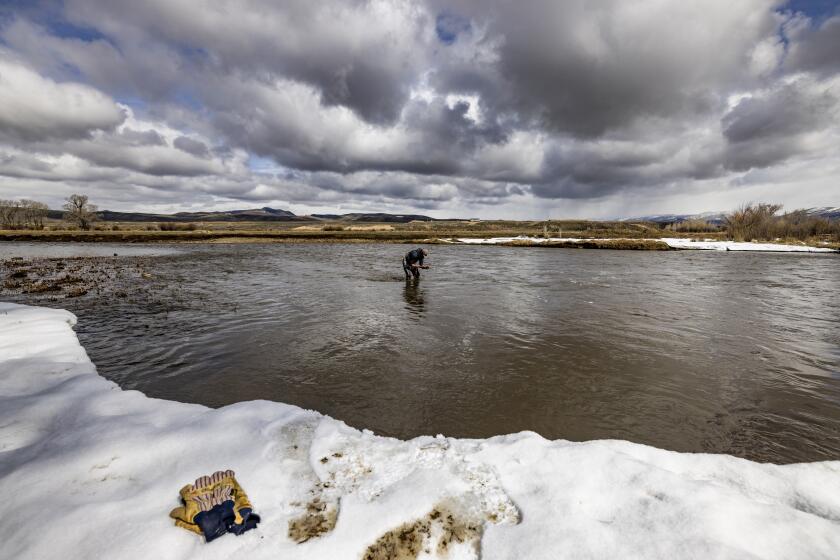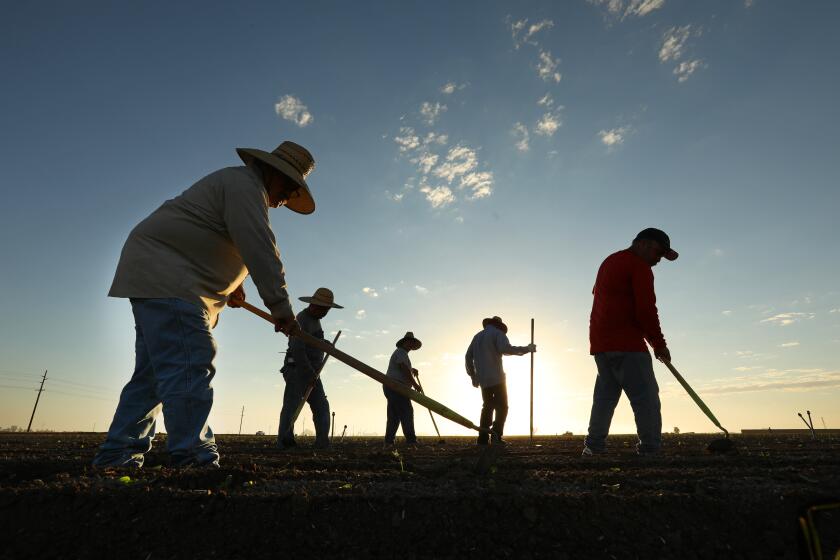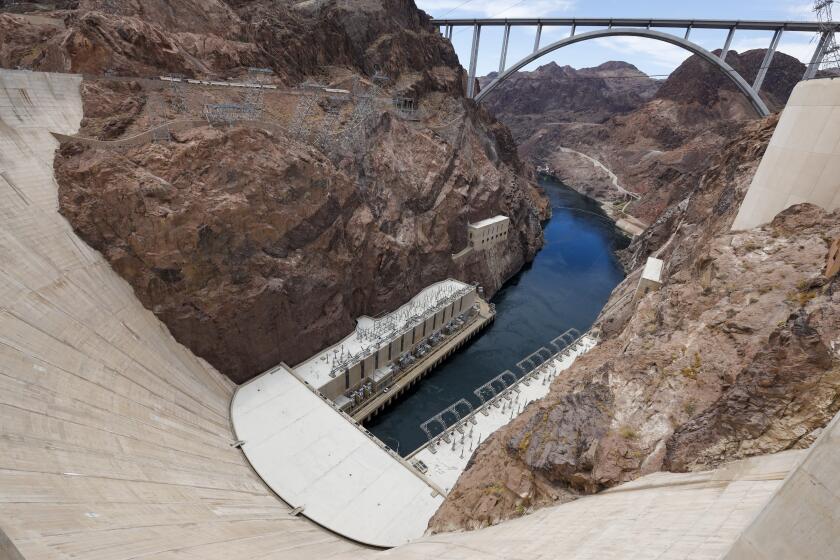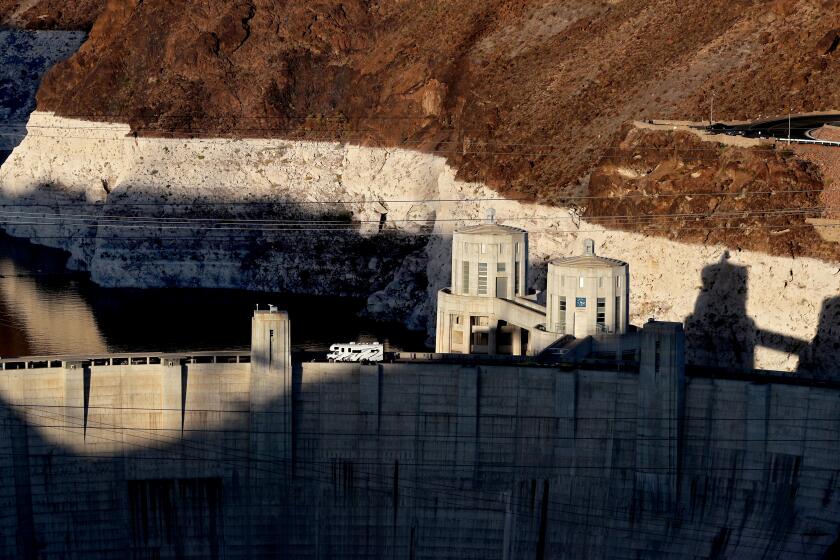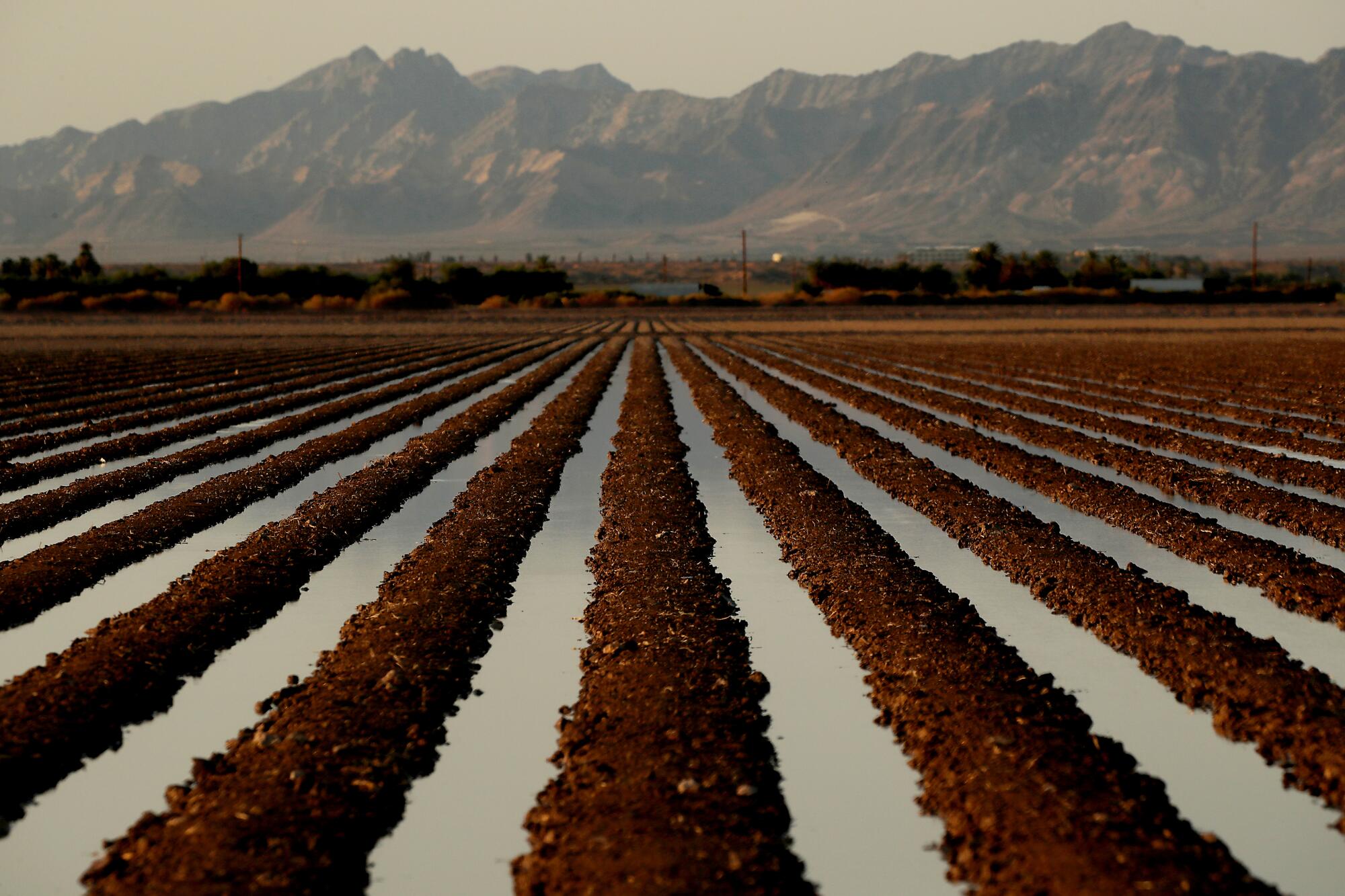
- Share via
With chronic water shortages afflicting the Colorado River, discussions about how to cut usage have increasingly focused on a thirsty crop that consumes an especially large share of the river’s water: hay that is grown to feed cattle and produce beef and dairy products.
In a new study, researchers found that alfalfa and other cattle-feed crops consume 46% of the water that is diverted from the river, accounting for nearly two-thirds of agricultural water use. The research also shows that agriculture is the dominant user of Colorado River water, accounting for 74% of the water that is diverted — about three times the combined usage of all the cities that depend on the river.
The study presents the most detailed analysis of its kind to date, including extensive data on where the river’s water goes across seven Western states and northern Mexico. The research sheds new light on how the river’s water is used at a time when representatives of the federal government, states and tribes are seeking long-term solutions to reduce water use and adapt to climate change.
“It’s important to understand where all of the water goes,” said Brian Richter, a researcher who led the study. “This is the first complete and detailed accounting.”
Richter said he hopes the findings will provide vital information for ongoing talks that will determine “what we want the future of the Colorado River to look like.”
The study, which involved a team of 12 researchers and was published in the journal Communications Earth & Environment, expands on previous research by including water use data for Mexico; the Gila River, a major tributary in Arizona; and supplies that are transported through canals and pipelines to areas outside the Colorado River Basin.
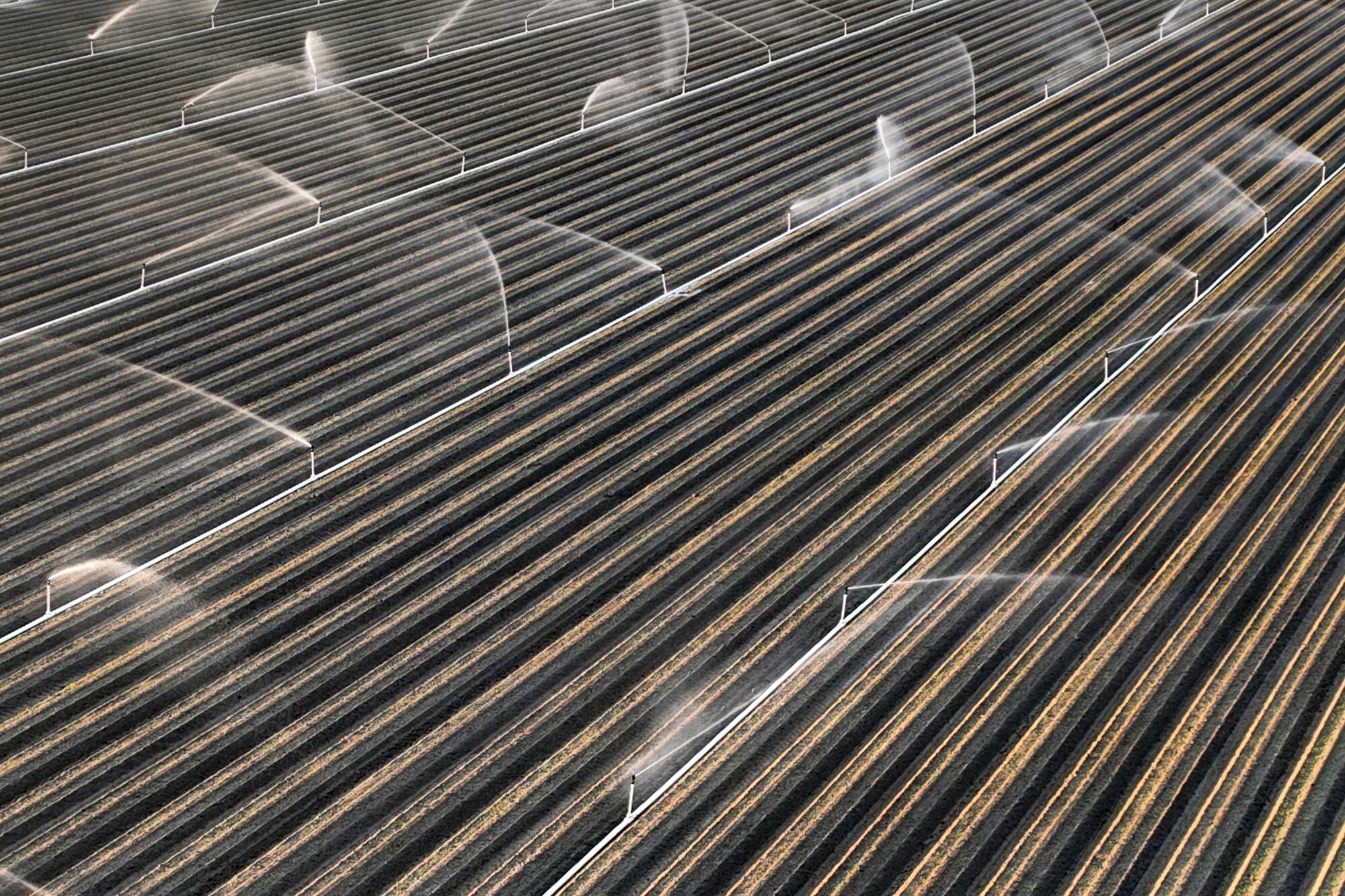
The researchers analyzed all water diversions for agriculture, communities and industries from 2000 to 2019, and calculated annual averages. They also included estimates of how much water evaporates from the river’s reservoirs, and the uptake of water by vegetation in wetlands and riparian areas along the river. Together, those account for 30% of overall consumption.
When additional losses that occur naturally along the river are factored in, agriculture accounts for 52% of overall consumption, including 32% of the total that goes toward irrigating alfalfa and other types of grass hay.
Cities — including municipal, commercial and industrial water use — account for the remaining 18% of overall water consumption.
The Colorado River supplies cities and farmlands in seven states from Wyoming to California, as well as 30 tribal nations. For decades, so much water has been diverted that the river has seldom met the sea and its once-vast wetlands in the river’s delta have dried up.
The Colorado River is approaching a breaking point, its over-tapped reservoirs dropping. Years of drying have taken a toll at the river’s source in the Rockies.
The river’s flow has declined dramatically since 2000, and research has shown that global warming worsened the long stretch of extremely dry years through 2022.
The river’s largest reservoirs, Lake Mead and Lake Powell, remain at low levels despite a series of water-saving agreements, and the region’s water managers have been engaged in difficult negotiations on new rules for dealing with shortages after 2026, when the current rules expire.
“We need to move out of a reactive mode and into a proactive mode for the long term,” said Richter, who is president of the organization Sustainable Waters and senior freshwater fellow for the World Wildlife Fund.
Richter noted that with agriculture using much of the water, there has been increasing attention focused on ways of achieving reductions in usage, and he said the research can help by detailing how much is going to different crops, such as hay, wheat, cotton and vegetables.
Over the last two decades, many cities in the Colorado River Basin have made progress in conserving water. In another study, Richter surveyed 28 urban water utilities and found that total water use dropped by 18% between 2000 and 2020, even as the population grew by 24%.
“The cities that depend upon the Colorado River are doing a miraculous job of reducing their needs for that water, and we now need to see a commensurate reduction in agriculture’s use of the river,” Richter said.
“We need to get very serious about shifting to a different mixture of crops, and we need to reduce the overall footprint, the acreage of land, that is being used for farmland,” Richter said.
As the federal government pushes states to reduce usage of dwindling Colorado River water, Imperial Valley farmers fear a “worst-case” scenario.
Alfalfa and other types of hay are especially water-intensive crops. In one report, Richter and other researchers compared the estimated water demands of different crops and found that alfalfa requires significantly more water per acre than cotton, corn or wheat.
Richter said the purpose of the research isn’t to point fingers at farmers for the crops they choose to grow, but rather to show where opportunities lie for switching crops and transforming agriculture in the Southwest.
“It’s important to acknowledge that farmers are growing what people want and are willing to pay for. And the reason we’re using so much of the Colorado River water to feed cows is because of our demand for beef and dairy products,” he said. “And our demand for dairy, and specifically cheese, has been going up, which is causing expansion of dairies in a lot of the West and in the Colorado River Basin, and so that’s why they’re growing so much alfalfa.”
Richter said that as a scientist, he is reluctant to tell people what to eat, and thinks everyone should “act on their conscience.”
“Personally, once I started this research, I gave up beef consumption altogether,” Richter said.
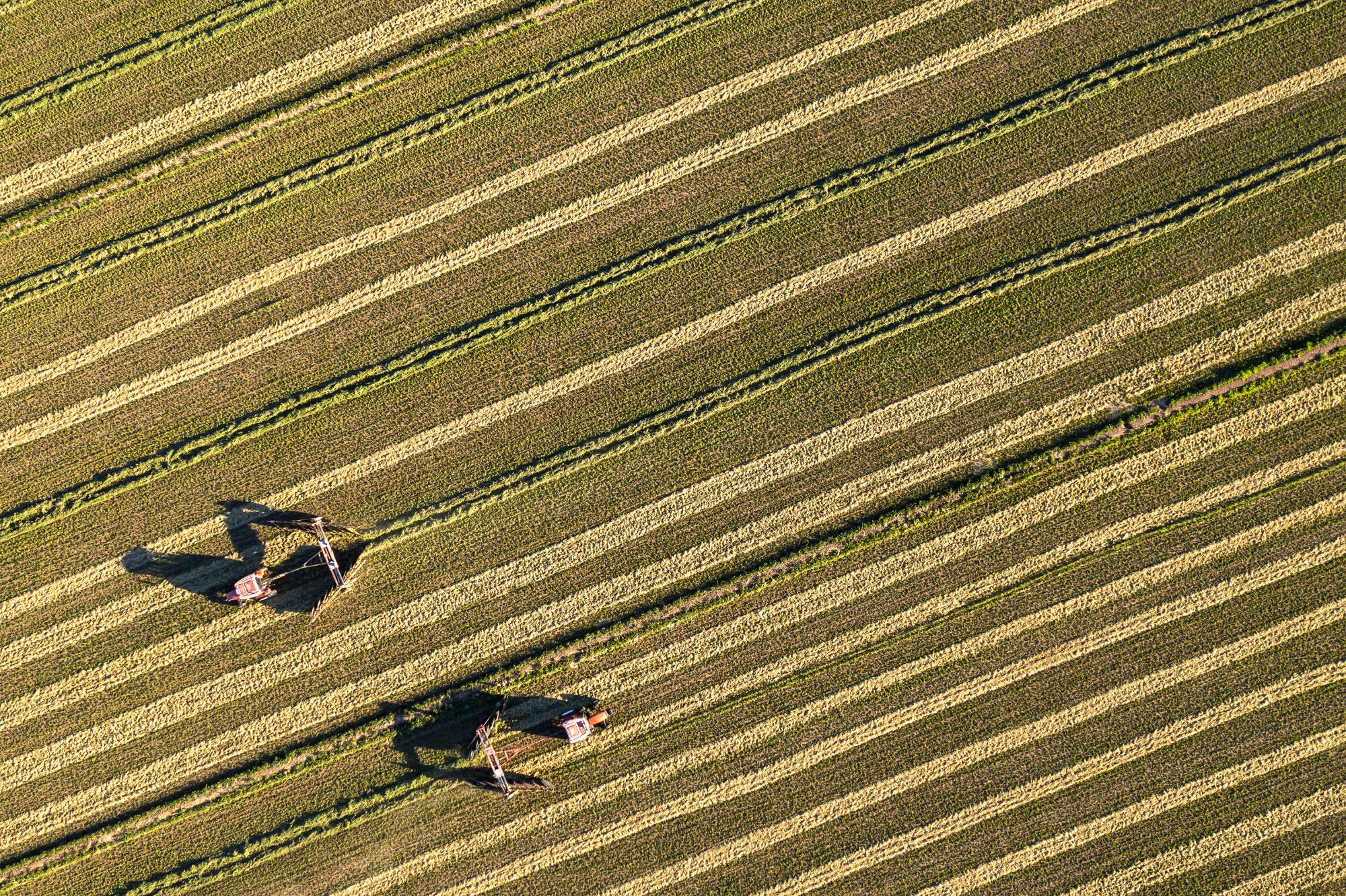
The study found regional differences in the Colorado River Basin, where the water irrigates more than 5 million acres of farmland and ranchland.
In the upper basin states — Colorado, Wyoming, Utah and New Mexico — cattle-feed crops consumed 90% of all water used by irrigated agriculture on average. In the lower basin states of California, Arizona and Nevada, hay accounted for 57% of agricultural water use, with more water going to crops such as wheat, cotton, oranges, lettuce and broccoli.
The researchers noted in the study that alfalfa is also attractive to growers for other reasons, including its hardiness and ability to survive with less water during droughts and then come back quickly once full irrigation resumes — functioning like a “shock absorber” for farmers dealing with unpredictable conditions.
Federal officials say short-term risks have eased on the Colorado River, providing ‘breathing room’ for talks on long-term plans to adapt to climate change.
Richter and other researchers have estimated that two-thirds of the alfalfa and other hay are used for beef cattle while the remaining third is used for dairy production.
Much of the hay is used to feed cows locally or in nearby states. But increasing amounts of hay have also been exported in recent years to countries such as China and Saudi Arabia. In one study, researchers at the University of Arizona examined crop data for seven Western states and estimated that 20% of the region’s total alfalfa production was exported in 2022.
Richter said he doesn’t think attempts at regulating crop types would work, but that creating financial incentives for growers to switch to less water-intensive crops can be effective. In a study last year, Richter and other scientists found that shifting from alfalfa to other types of hay, vegetable crops or wheat would save substantial amounts of water.
Reducing water use in agriculture, something that can come partly by growing a different mix of crops, is increasingly urgent as climate change continues to sap the river’s flow, Richter said.

Scientists have found that higher temperatures, driven by fossil fuel burning and rising levels of greenhouse gases, have reduced the river’s flow by about 10% so far, and the toll is projected to worsen as warming continues.
“There just simply isn’t enough water to continue growing what we’ve been growing for the last hundred years,” Richter said. “We need to find a way to help the farmers make the necessary transition and help protect them from going broke.”
Short-term efforts to cut water use in the region rely partly on payments of federal funds to agricultural landowners, water districts, tribes and cities that have agreed to reduce usage.
For example, growers in the Palo Verde Irrigation District in Blythe, Calif., have been participating in a program in which they agree to leave some farmland dry and fallow in exchange for cash payments on a rotating basis.
Some efforts to cut water use have run into complications. California’s Imperial Irrigation District had been planning to start a conservation program next month that would pay farmers to temporarily stop watering some crops, but the start of the effort was put on hold after environmentalists raised concerns that dry irrigation drains could threaten endangered desert pupfish, which live along the shore of the Salton Sea and in nearby ponds.
Concerns about the endangered desert pupfish delay Colorado River conservation plans in Imperial Valley
As the region’s water managers continue negotiating long-term approaches for reducing water use, Richter said it will be vital to create a fund with federal and state support to help farmers change crops or retire some cropland.
The researchers wrote in the study that they hope their accounting will provide a “useful informational foundation to the public [dialogue] and political negotiations over Colorado River Basin water allocations and cutbacks.”
They also said their new accounting shows “why the Colorado River no longer reaches the sea,” estimating that from 2000 to 2019, an average of 19.3 million acre-feet of water was used up before the river reached its desiccated end in Mexico.
“More water needs to remain in the river system to prevent species extinctions and restore wetlands,” Richter said, pointing out that water diversions and dam operations have put at risk two-thirds of the native fish species in the Colorado River Basin, among them the Colorado pikeminnow and humpback chub.
Former Interior Secretary Bruce Babbitt, who oversaw management of the river under President Clinton, said the findings will help provide a solid factual base for discussions about the river’s future.
“The role of irrigated agriculture is now front and center, because if we’re going to find an agreement in the current negotiations, it is going to require significant agricultural reductions across the basin,” Babbitt said.
Former Interior Secretary Bruce Babbitt says with climate change shrinking the Colorado River, Western states should renegotiate a key 1922 agreement.
He has suggested creating a long-term regionwide program that would provide funding to support cuts in agricultural water use through seasonal land-fallowing, with limits aimed at protecting farming communities.
“We’re going to have to begin setting up frameworks at the state and national level to get this process going, to come to a conclusion about how you put together voluntary programs that have incentives, that do not destroy local communities,” Babbitt said.
For the next three years, federal funds from the Bipartisan Infrastructure Law and the Inflation Reduction Act are supporting the water-saving efforts. Babbitt said one key question will be where the federal government can find money for a long-term program aimed at scaling back agricultural water use.
“The transition that we have to make in the next decade — reducing consumption to balance water availability and water use — is not going to be a catastrophic change,” Babbitt said.
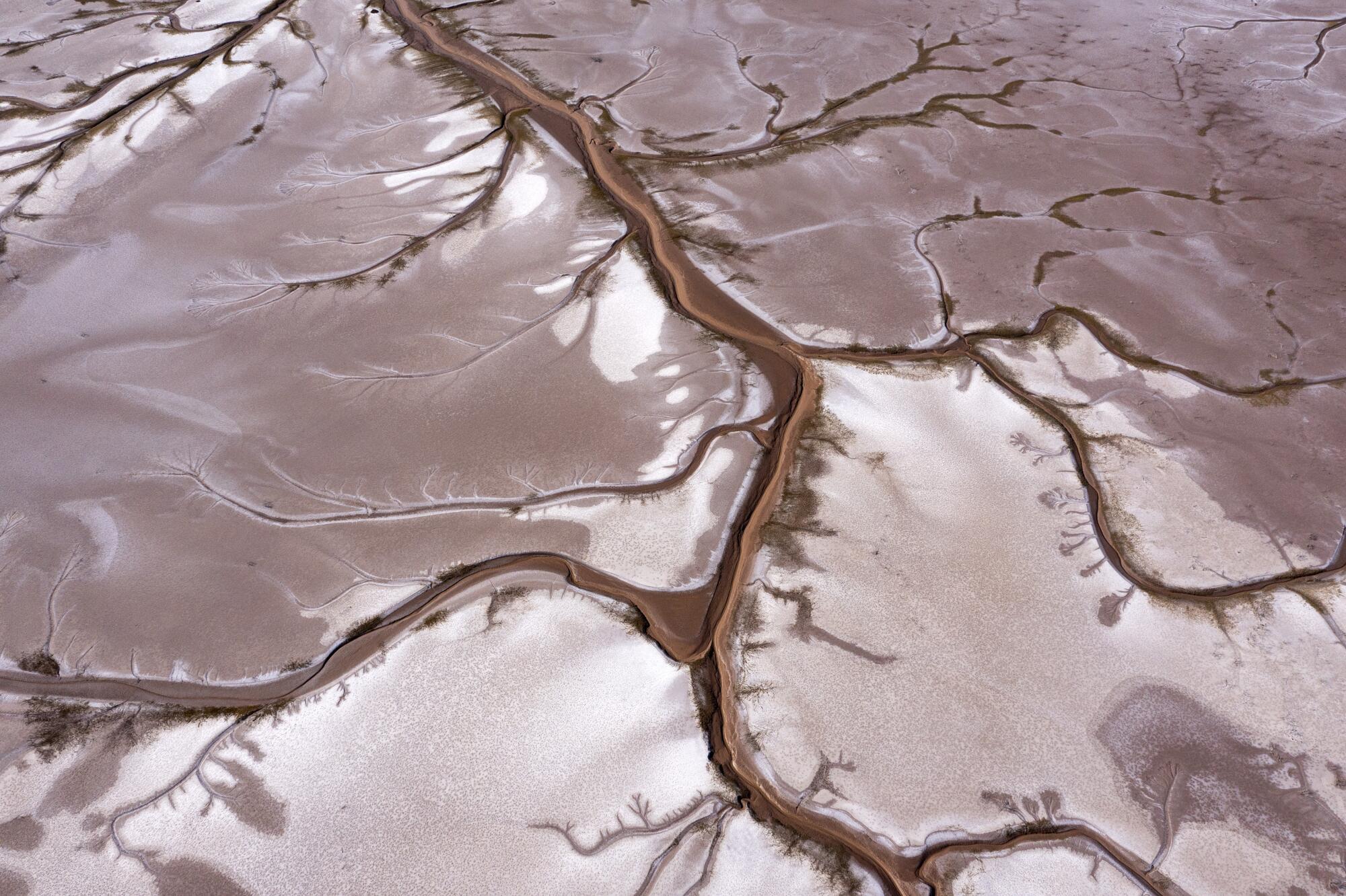
He cited estimates that addressing the river’s chronic overuse will require reducing usage by 20% to 25%.
“It’s a crisis only if we do nothing, but if we set about doing it in a thoughtful way, it’s manageable,” Babbitt said.
As for the large acreages now growing alfalfa, Babbitt noted that the crop generates relatively low returns and is often the first one taken out of production when farmers agree to temporarily fallow fields. He said that makes the crop an obvious place to begin reducing water use.
“It is the most economical way, in the Colorado River Basin, of reducing consumption,” he said. “There are plenty of other areas in this country where there is more than adequate water to grow alfalfa and animal feed.”
Times staff writer Hayley Smith contributed to this report.
Toward a more sustainable California
Get Boiling Point, our newsletter exploring climate change, energy and the environment, and become part of the conversation — and the solution.
You may occasionally receive promotional content from the Los Angeles Times.
